Go 并發(fā)可視化解釋 - sync.Mute
在學(xué)習(xí) Go 編程語(yǔ)言時(shí),您可能會(huì)遇到這句著名的格言:“不要通過(guò)共享內(nèi)存來(lái)進(jìn)行通信;相反,通過(guò)通信來(lái)共享內(nèi)存。” 這句話構(gòu)成了 Go 強(qiáng)大并發(fā)模型的基礎(chǔ),其中通道(channels)作為協(xié)程之間的主要通信工具。然而,雖然通道是管理并發(fā)的多功能工具,但錯(cuò)誤地假設(shè)我們應(yīng)該始終用通道替換傳統(tǒng)的鎖定機(jī)制,如 Mutex,是一個(gè)錯(cuò)誤的觀念。在某些情況下,使用 Mutex 不僅恰當(dāng),而且比通道更有效。
在我的 Go 并發(fā)可視化系列中,今天我將通過(guò)視覺(jué)方式來(lái)解釋 sync.Mutex。

Golang 基礎(chǔ)
場(chǎng)景
想象一下,有四位 Gopher 自行車(chē)手每天騎車(chē)上班。他們都需要在到達(dá)辦公室后洗個(gè)澡,但辦公室只有一個(gè)浴室。為了防止混亂,他們確保一次只能有一個(gè)人使用浴室。這種獨(dú)占式訪問(wèn)的概念正是 Go Mutex(互斥鎖)的核心。

每天早上在辦公室洗澡對(duì)自行車(chē)手和跑步者來(lái)說(shuō)是一個(gè)小小的競(jìng)爭(zhēng)。
普通模式
今天最早到達(dá)的是 Stringer。當(dāng)他來(lái)的時(shí)候,沒(méi)有人在使用浴室,因此他可以立即使用浴室。
對(duì)一個(gè)未加鎖的 Mutex 調(diào)用 Lock() 會(huì)立即成功。
片刻后,Partier 到了。Partier 發(fā)現(xiàn)有人在使用浴室,但他不知道是誰(shuí),也不知道什么時(shí)候會(huì)結(jié)束使用。此時(shí),他有兩個(gè)選擇:站在浴室前面(主動(dòng)等待),或者離開(kāi)并稍后再回來(lái)(被動(dòng)等待)。按 Go 的術(shù)語(yǔ),前者被稱(chēng)為“自旋”(spinning)。自旋的協(xié)程會(huì)占用 CPU 資源,增加了在鎖定可用時(shí)獲取 Mutex 的機(jī)會(huì),而無(wú)需進(jìn)行昂貴的上下文切換。然而,如果 Mutex 不太可能很快可用,繼續(xù)占用 CPU 資源會(huì)降低其他協(xié)程獲取 CPU 時(shí)間的機(jī)會(huì)。
從版本 1.21 開(kāi)始,Golang 允許到達(dá)的協(xié)程自旋一段時(shí)間。如果在指定時(shí)間內(nèi)無(wú)法獲取 Mutex,它將進(jìn)入休眠狀態(tài),以便其他協(xié)程有機(jī)會(huì)運(yùn)行。
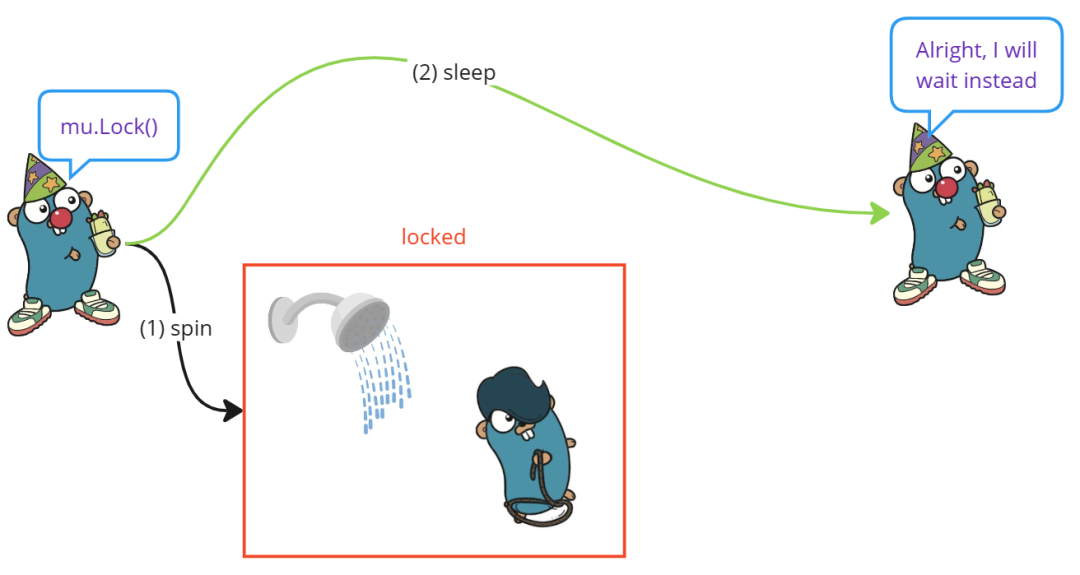
到達(dá)的協(xié)程首先自旋,然后休眠。
Candier 到了。就像 Partier 一樣,她試圖獲取浴室。
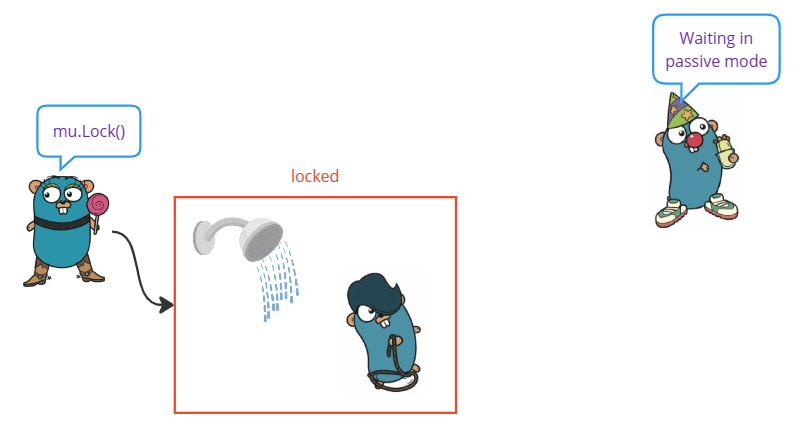
因?yàn)樗齽偟剑绻?Stringer 很快釋放浴室,她就有很大的機(jī)會(huì)在被動(dòng)等待之前獲取它。這被稱(chēng)為普通模式。
普通模式的性能要好得多,因?yàn)閰f(xié)程可以連續(xù)多次獲取 Mutex,即使有阻塞的等待者。
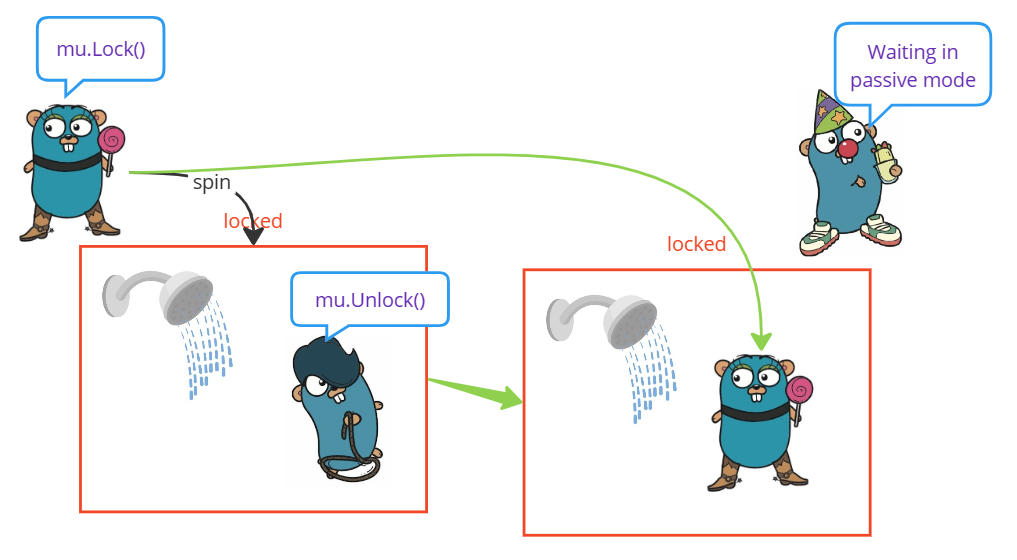
1*GJ7OW0_8z_8QjXPa2cFxPw.png
go/src/sync/mutex.go at go1.21.0 · golang/go · GitHub[1]新到達(dá)的協(xié)程在爭(zhēng)奪所有權(quán)時(shí)具有優(yōu)勢(shì)。
饑餓模式
Partier 回來(lái)了。由于他等待的時(shí)間很長(zhǎng)(超過(guò) 1 毫秒),他將嘗試以饑餓模式獲取浴室。當(dāng) Swimmer 來(lái)時(shí),他注意到有人餓了,他不會(huì)嘗試獲取浴室,也不會(huì)自旋。相反,他會(huì)排隊(duì)在等待隊(duì)列的尾部。
在這種饑餓模式下,當(dāng) Candier 結(jié)束時(shí),她會(huì)直接把浴室交給 Partier。此時(shí)沒(méi)有競(jìng)爭(zhēng)。
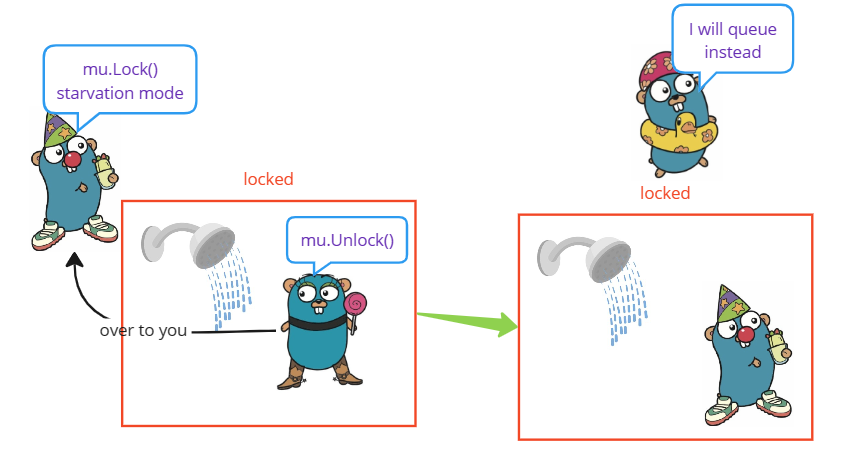
饑餓模式是防止尾延遲的病理情況的重要措施。
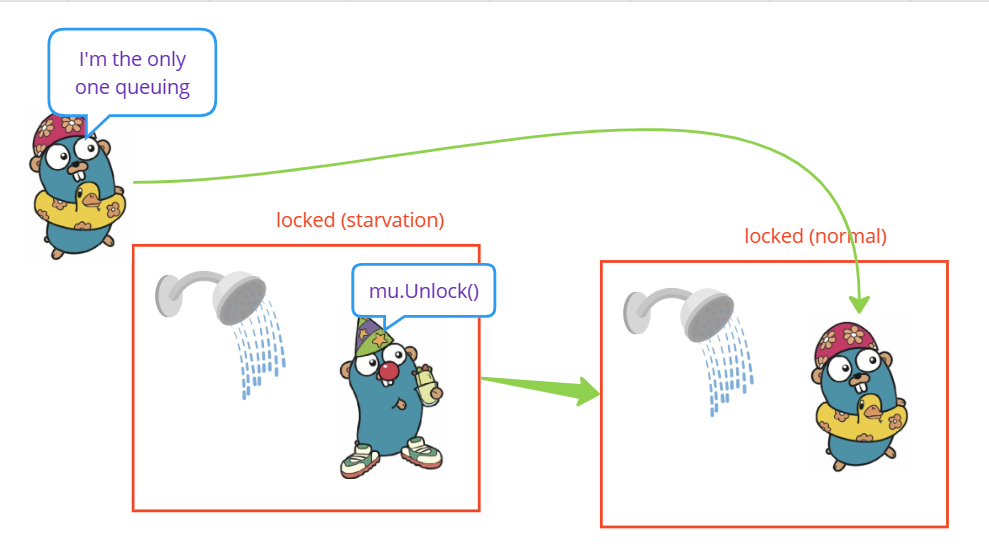

Partier 完成了他的回合并釋放了浴室。此時(shí),只有 Swimmer 在等待,因此他將立即擁有它。Swimmer 如果發(fā)現(xiàn)自己是最后一個(gè)等待的人,他會(huì)將 Mutex 設(shè)置回普通模式。如果他發(fā)現(xiàn)自己的等待時(shí)間少于 1 毫秒,也會(huì)這樣做。
最后,Swimmer 在使用浴室后釋放了它。請(qǐng)注意,Mutex 不會(huì)將所有者從“已鎖定(由 Goroutine A 鎖定)”狀態(tài)更改為“已鎖定(由 Goroutine B 鎖定)”狀態(tài)。它始終會(huì)在“已鎖定”到“未鎖定”然后再到“已鎖定”的狀態(tài)之間切換。出于簡(jiǎn)潔起見(jiàn),上面的圖像中省略了中間狀態(tài)。
展示代碼!
Mutex 的實(shí)現(xiàn)隨時(shí)間而變化,實(shí)際上,要完全理解它的實(shí)現(xiàn)并不容易。幸運(yùn)的是,我們不必完全理解其實(shí)現(xiàn)就能高效使用它。如果從這篇博客中只能記住一件事,那一定是:早到的人不一定贏得比賽。相反,新到達(dá)的協(xié)程通常具有更高的機(jī)會(huì),因?yàn)樗鼈內(nèi)栽?CPU 上運(yùn)行。Golang 還嘗試避免通過(guò)實(shí)現(xiàn)饑餓模式來(lái)使等待者被餓死。
package main
import (
"fmt"
"sync"
"time"
)
func main() {
wg := sync.WaitGroup{}
wg.Add(4)
bathroom := sync.Mutex{}
takeAShower := func(name string) {
defer wg.Done()
fmt.Printf("%s: I want to take a shower. I'm trying to acquire the bathroom\n", name)
bathroom.Lock()
fmt.Printf("%s: I have the bathroom now, taking a shower\n", name)
time.Sleep(500 * time.Microsecond)
fmt.Printf("%s: I'm done, I'm unlocking the bathroom\n", name)
bathroom.Unlock()
}
go takeAShower("Partier")
go takeAShower("Candier")
go takeAShower("Stringer")
go takeAShower("Swimmer")
wg.Wait()
fmt.Println("main: Everyone is Done. Shutting down...")
}正如您可能猜到的,并發(fā)代碼的結(jié)果幾乎總是非確定性的。
第一次
Swimmer: I want to take a shower. I'm trying to acquire the bathroom
Partier: I want to take a shower. I'm trying to acquire the bathroom
Candier: I want to take a shower. I'm trying to acquire the bathroom
Stringer: I want to take a shower. I'm trying to acquire the bathroom
Swimmer: I have the bathroom now, taking a shower
Swimmer: I'm done, I'm unlocking the bathroom
Partier: I have the bathroom now, taking a shower
Partier: I'm done, I'm unlocking the bathroom
Candier: I have the bathroom now, taking a shower
Candier: I'm done, I'm unlocking the bathroom
Stringer: I have the bathroom now, taking a shower
Stringer: I'm done, I'm unlocking the bathroom
main: Everyone is Done. Shutting down...
第二次
Swimmer: I want to take a shower. I'm trying to acquire the bathroom
Swimmer: I have the bathroom now, taking a shower
Partier: I want to take a shower. I'm trying to acquire the bathroom
Stringer: I want to take a shower. I'm trying to acquire the bathroom
Candier: I want to take a shower. I'm trying to acquire the bathroom
Swimmer: I'm done, I'm unlocking the bathroom
Partier: I have the bathroom now, taking a shower
Partier: I'm done, I'm unlocking the bathroom
Stringer: I have the bathroom now, taking a shower
Stringer: I'm done, I'm unlocking the bathroom
Candier: I have the bathroom now, taking a shower
Candier: I'm done, I'm unlocking the bathroom
main: Everyone is Done. Shutting down...
自己實(shí)現(xiàn) Mutex
實(shí)現(xiàn) sync.Mutex 是困難的,但使用具有緩沖的通道來(lái)實(shí)現(xiàn) Mutex 卻相當(dāng)容易。
type MyMutex struct {
ch chan bool
}
func NewMyMutex() *MyMutex {
return &MyMutex{
// 緩沖大小必須為 1
ch: make(chan bool, 1),
}
}
// Lock 鎖定 m。
// 如果鎖已被使用,調(diào)用的協(xié)程將被阻塞,直到 Mutex 可用。
func (m *MyMutex) Lock() {
[m.ch](http://m.ch) <- true
}
// Unlock 解鎖 m。
func (m *MyMutex) Unlock() {
<-m.ch
}這篇文章通過(guò)生動(dòng)的場(chǎng)景和可視化效果很好地解釋了 Go 語(yǔ)言中 sync.Mutex 的工作原理,以及如何使用互斥鎖來(lái)管理并發(fā)





































